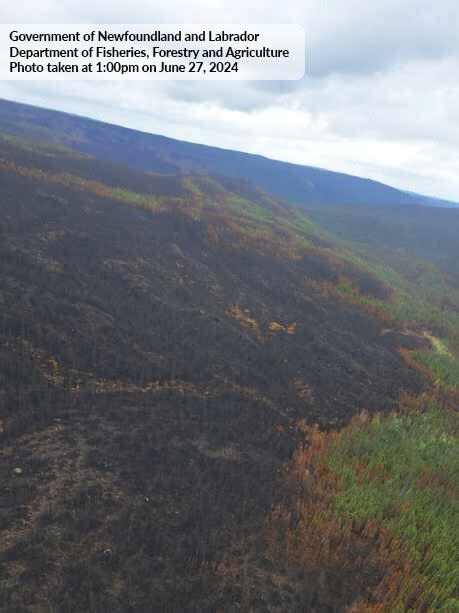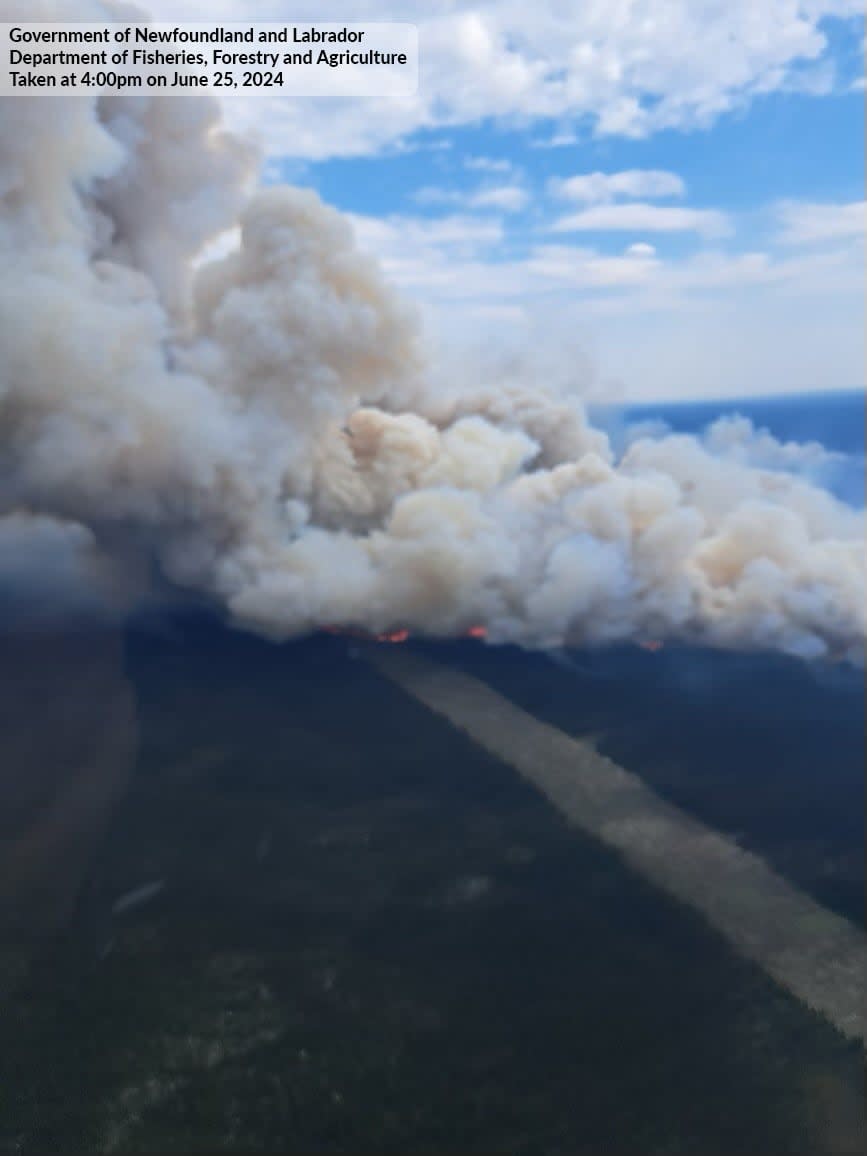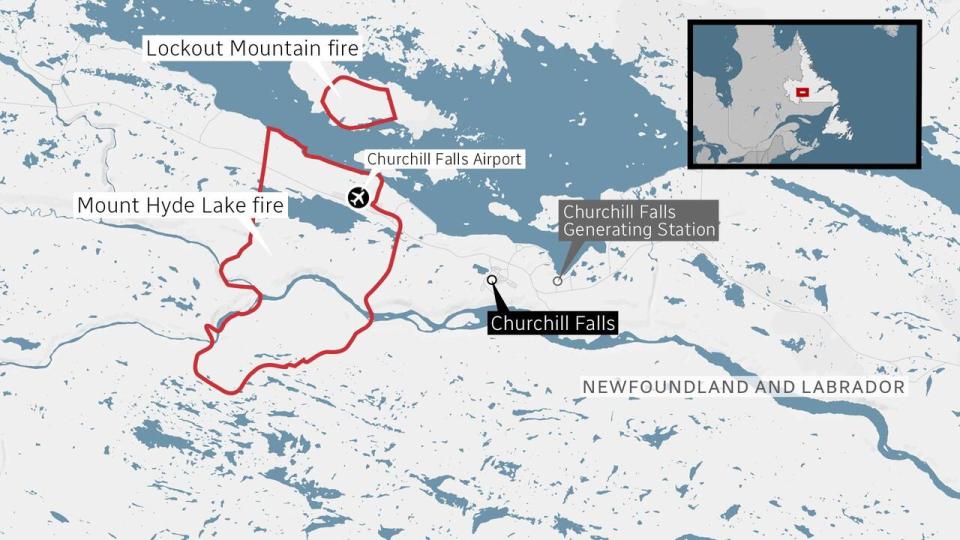With help from favourable weather, Churchill Falls fire drops to Level 1, says Furey

Rainfall, humidity and lower temperatures have teamed up to tone down dramatically the threat that an out-of-control forest fire in central Labrador has posed to one of North America's largest power plants.
Rainy conditions on Thursday, however, meant water bombers could not attack the fire on the outskirts of Churchill Falls, provincial fire duty officer Laurie Holloway told CBC News. About 14 millimetres of rain have fallen since Wednesday.
Instead, crews used helicopters to deal with a fire that has substantially been downgraded because of a favourable change in the weather.
Newfoundland and Labrador Premier Andrew Furey said earlier that the Churchill Falls fire has been downgraded to Level 1, a significant drop from the Level 5 and Level 6 categories from earlier this week, when managers fully evacuated the Upper Churchill hydroelectric power plant.
About 750 people were ordered on June 19 to flee Churchill Falls, a company town that exists to keep Newfoundland and Labrador Hydro's generating station running.
On Tuesday, the fire had jumped the Churchill River — which had been acting as a natural barrier keeping the flames from reaching the town — and prompted an order for the final workers to leave.
N.L. Hydro CEO Jennifer Williams told reporters Thursday reinforcements — some of them retired employees — are being brought in to relieve the staff who remained behind to keep the plant running before being evacuated to Happy Valley-Goose Bay, where they continued to monitor operations.
"There is definitely a gleam of optimism on the horizon for folks when we continue to hear the assessments from government with regard to the fire status," she said.
"It's important to know, for people who are from Churchill Falls, that the fire has not reached their homes or businesses, and we are hopeful that this information does bring comfort to them."
Williams said the fire is smouldering, roughly four kilometres from town, and didn't progress overnight.
While the fire has forced workers off site, the plant is still operating with reduced function. It is being monitored remotely, while some limited operations can be done from other locations.
On Wednesday night, Furey posted on X, formerly known as Twitter, that Wednesday's weather had a positive impact in efforts to fight the fire and it was now a Level 1 fire.

"Crews continue monitoring the situation, as [N.L. Hydro] works to protect the power supply and support employees through this difficult time," he wrote.
Thursday marked the third day in a row that water bombers could not do their work properly.
On Tuesday, flames were too intense for water bombers to continue their attacks on the blaze. On Wednesday, smoky conditions kept water bombers on the ground.
Lawlor said Thursday morning the fire was three to four kilometres from Churchill Falls.
When crews left the area Wednesday night, he said, there were only smouldering ground fires and no open flames.
"[It] should be a very good day for our people on the ground in Churchill Falls," Lawlor told CBC News on Thursday morning.
Thursday's plan to attack the fire will include helicopters, water bombers and ground crews, he said.
Photos released by the Department of Fisheries, Forestry and Agriculture show swaths of land burned and charred from the fire that swept over it.
Cooler and wetter weather ahead
Environment Canada meteorologist Rodney Barney said temperatures in the area Thursday should be cooler and damp, adding that the breakfast-time temperature was around 5 C. The wind is anticipated to blow lightly in a northeast direction, blowing smoke away from the community.
The rainfall that dropped in the preceding day was also good news, he said. "That, combined with the cooler temperatures, higher relative humidity … all would be in favour of suppressing any activity, certainly, as we go forward," Barney told CBC News.
In the next few days, the weather is expected to be cooler and damper. Next week, however, the forecast calls for a return of warmer and drier temperatures, Barney said.
Lawlor is also optimistic about the weather heading into the weekend.
"Given the current forecast, it will really help us," Lawlor said.
Lawlor deferred questions Thursday about the power plant's status to N.L. Hydro but said he believed it was still operational. On Wednesday, some essential workers were on site but they were commuting from Happy Valley-Goose Bay, 290 kilometres away, and he couldn't say when they could return permanently.

According to Newfoundland and Labrador's wildfire dashboard, there were 10 fires burning in Labrador on Thursday afternoon — up one from Wednesday morning's count. The new fire, which started Tuesday at Grand Lake, is listed as under control.
The two fires threatening Churchill Falls continue to burn, with the Mount Hyde Lake fire — the one most concerning to the town — still listed as out of control. A fire near Twin Falls is being held.
As of Wednesday afternoon, Furey said, fires had not reached the town's perimeter.
The fire has also affected power supply to customers. Parts of Labrador West were without power Tuesday after dropped water tripped power lines at Churchill Falls.
Power has now been restored to all customers in Labrador City and Wabush, the twin mining towns in western Labrador. Electricity for Labrador City has been coming from Hydro-Québec, but the town will move back to its regular supply.
Download our free CBC News app to sign up for push alerts for CBC Newfoundland and Labrador. Click here to visit our landing page


